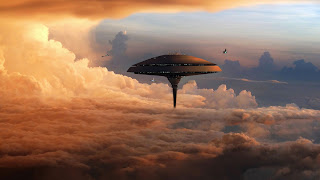 |
| Picture I |
http://kimmontaidearvioita.blogspot.com/p/the-havoc-plan-of-nasa.html
Kimmo Huosionmaa
When we are thinking about the floating city in the atmosphere of some planets, we might think that this structure would need very much fuel or nuclear propulsion for floating above the clouds. That would not be necessarily true, even this city or giant spacecraft would stay in the atmosphere of some hostile planet.
Of course, the nuclear power and the turbines would keep the heavier than air-structure above the planet Venus, and the "heavier than air"-solution makes those systems very weird, but this kind of structure is safer than airships, but there is one problem. Staying in the atmosphere that system needs machine power and this kind of structures is no experiences before this program. The HAVOC (High Altitude Venus Operational Concept) could be heavier than air because this structure is not so sensitive for the winds, and that could make the thing safer, but the problem is that the motors of the device must operate all the time, but the leaks are less devastating than with airships.
Of course, the airship, what uses the structure, what is like cells is safer than the nowadays airships, and in that structure, the gas tank of the aircraft is filled with the small cells, what can be closed independently. That structure helps to minimize the gas leak from the airship. And the system is made with ultra-light carbon fiber or the artificial diamond layer, what can be the only couple of micrometers thick. This material can be welded together by using melted carbon fiber, what is also very hard material.
There would be the possibility to use the long capillary stick, what would suck the gas from the atmosphere thru it, and then this air would be turned down, what causes that this giant building might get enough rising force, that this structure would be in the atmosphere of the planet. Another structure of that floating system could be the parachute-type system, and under those parachutes would be conducted with the rising gas. Those parachutes will be floated this structure over the clouds. But this capillary system needs an extremely long tube, that the rising gas can raise the tens of tons system. The "cloud city" can fly to the target planet as the normal spacecraft, and then it can be parked in the atmosphere.
That kind of city or giant structure would be used as the investigation station for the planet Venus, but it kind if systems can be used at the bases in the atmosphere of the gas giants. In theory, it could allow making investigation layers, where the astronauts can walk like in some Sci-Fi movie, and collect the samples from the lower atmosphere. This kind of systems seems very interesting, but there will be some difficulties to make those things really working. The big structure is needed because in the Venus or other planets would be needed very much equipment, and the astronauts would also need little privacy sometimes.
https://sacd.larc.nasa.gov/smab/havoc/
Picture I
http://cdn.gospelherald.com/data/images/full/8738/nasa-venus-mission.jpg




No comments:
Post a Comment
Note: Only a member of this blog may post a comment.